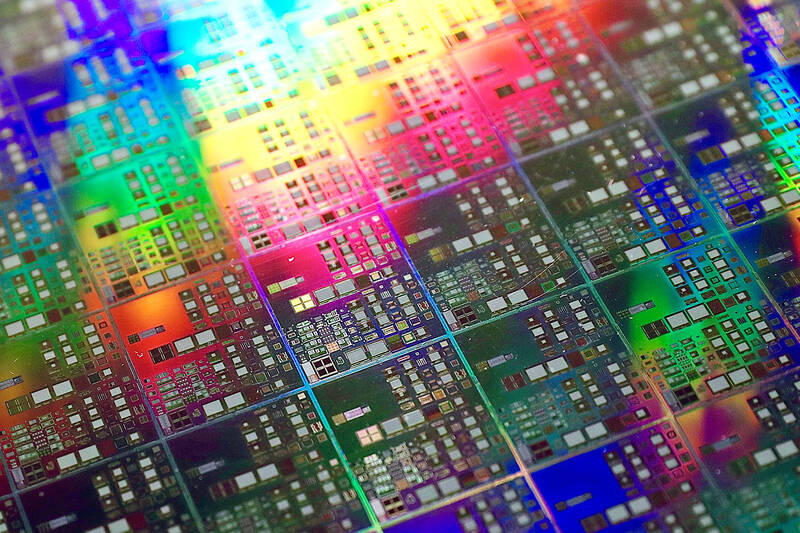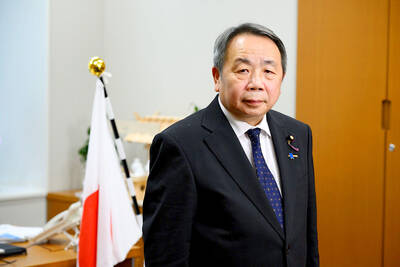Taiwan plans to boost cooperation with the Czech Republic in semiconductor development due to Prague’s pivotal role in the European IC industry, Executive Yuan Secretary-General Kung Ming-hsin (龔明鑫) said.
With Taiwan Semiconductor Manufacturing Co (TSMC) building a wafer fab in the German city of Dresden, a Germany-Czech Republic-Poland “silicon triangle” is forming, Kung said in a media interview on the weekend after returning from a visit to Prague.
“Prague is closer to Dresden than Berlin is, so Taiwanese firms are expected to take advantage of the Czech capital’s location,” he said. “Taiwan and Prague have already launched direct flights and it is convenient for Taiwanese firms to fly one to two hours from Prague to Dresden.”

Photo: Ritchie B. Tongo, EPA-EFE
As a result of TSMC’s investments in Germany, semiconductor investors would be able to build an industrial cluster in the Czech Republic, Kung said.
“I am upbeat that the Czech Republic will serve as a springboard for Taiwan’s semiconductor industry to penetrate the European market,” he said.
On Aug. 20, TSMC broke ground on a 12-inch wafer fab in Dresden through a joint venture called European Semiconductor Manufacturing Co (ESMC), which includes Robert Bosch GmbH, Infineon Technologies AG and NXP Semiconductors NV.
Construction of the facility is likely to start this year, with production scheduled to begin at the end of 2027.
Total investment is estimated to top 10 billion euros (US$11.1 billion), with TSMC having a 70 percent stake and each of its three partners having 10 percent stakes.
The EU Commission has approved 5 billion euros in subsidies for the project under the EU Chips Act.
Meanwhile, the Ministry of Economic Affairs is planning to set up a service office in the Czech Republic to provide Taiwanese investors with assistance to set up a foothold in Europe.
In the interview, Kung, said that his visit to the Czech Republic was the third time he had visited the country since 2021, when he was head of the National Development Council (NDC).
That trip included a visit to Prague and both sides signed multiple memoranda of understanding on industrial cooperation, he said.
Kung visited the country again last year to iron out details of the deal.
During that visit, Kung marked a map with a circle during a meeting to highlight the proximity of Prague to Dresden after TSMC announced its Germany investment plan earlier that year.
Taiwanese semiconductor suppliers would build a large cluster in the Czech Republic, he said at the time.
Last month’s delegation was comprised of officials from government agencies including the NDC, the ministry and the National Science and Technology Council, as well as representatives from 16 semiconductor firms.
“Many Taiwanese companies have realized the importance of the Czech Republic, where they are seeing business opportunities,” Kung said. “They appear more and more interested in going to the Czech Republic now.”
Last month’s delegation also visited other Czech cities such as Brno, which is known for its technology and academic development, and is where AI server manufacturer Wistron Corp runs a facility, he said.
It also visited Kutna Hora, where iPhone assembler Hon Hai Precision Industry Co set up a complex in 2000, and Usti nad Labem, which is a 40-minute drive from Dresden and is expected to become a top destination for Taiwanese semiconductor firms.
The government welcomes students from Germany and other countries to study related fields in Taiwan and provides scholarships, Kung added.
Through cooperation between the government, industries and academics, Taiwan aims to develop a large semiconductor talent pool by persuading such students to stay in Taiwan after they finish their studies, he said.

A strong continental cold air mass is to bring pollutants to Taiwan from tomorrow, the Ministry of Environment said today, as it issued an “orange” air quality alert for most of the country. All of Taiwan except for Hualien and Taitung counties is to be under an “orange” air quality alert tomorrow, indicating air quality that is unhealthy for sensitive groups. In China, areas from Shandong to Shanghai have been enveloped in haze since Saturday, the ministry said in a news release. Yesterday, hourly concentrations of PM2.5 in these areas ranged from 65 to 160 micrograms per cubic meter (mg/m³), and pollutants were

Taiwan’s armed forces have established response protocols for a wide range of sudden contingencies, including the “Wan Chun Plan” to protect the head of state, the Ministry of Defense (MND) said today. After US President Donald Trump on Saturday launched a series of airstrikes in Venezuela and kidnapped Venezuelan President Nicolas Maduro, concerns have been raised as to whether China would launch a similar “decapitation strike” on Taiwan. The armed forces regularly coordinate with relevant agencies and practice drills to ensure preparedness for a wide range of scenarios, Vice Minister of National Defense Hsu Szu-chien (徐斯儉) told reporters before a

EVA Airways on Saturday said that it had suspended a pilot and opened an investigation after he allegedly lost his temper and punched the first officer several times as their plane was taxiing before takeoff at Los Angeles International Airport. According to a report published on Thursday by The Reporter, the incident occurred after the flight’s Malaysian first officer tried to warn the Taiwanese pilot, surnamed Wen (文), that he was taxiing faster than the speed limit of 30 knots (55.6kph). After alerting the pilot several times without response, the first officer manually applied the brakes in accordance with standard operating

Japanese Councilor Hei Seki (石平) on Wednesday said that he plans to visit Taiwan, saying that would “prove that Taiwan is an independent country and does not belong to China.” Seki, a member of the Japan Innovation Party, was born in Chengdu in China’s Sichuan Province and became a naturalized Japanese in 2007. He was elected to the House of Concilors last year. His views on the Chinese Communist Party (CCP) — espoused in a series of books on politics and history — prompted Beijing to sanction him, including barring Seki from traveling to China. Seki wrote on X that he intends